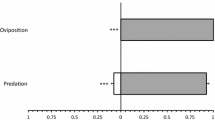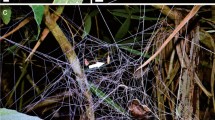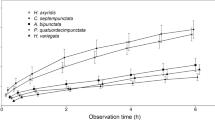Abstract
Ladybirds face a diversity of potential predators from which their main protection is powerful alkaloid-based chemical defence. In the laboratory, adults of the European orb-web spider Araneus diadematus Clerck readily consumed the native European ladybird Coccinella septempunctata L. and non-melanics and melanics of the exotic Harmonia axyridis (Pallas). The spider was little deterred by their defensive chemistry and apparently suffered no ill effects after eating ladybirds. This is particularly notable for H. axyridis, which possesses a novel alkaloid not known from European ladybirds and to which European predators are not expected to be adapted. Examination of inhabited A. diadematus webs and experimental determination of for how long captured ladybirds remained in webs indicated that ≤2% of spiders consume a ladybird each day. Ladybirds and A. diadematus are probably complementary rather than antagonistic in controlling crop pests, with ladybirds being at greatest risk from A. diadematus predation in autumn, during migration to overwintering sites.


Similar content being viewed by others
References
Alam N, Choi IS, Song K-S, Hong J, Lee CO, Jung JH (2002) A new alkaloid from two coccinellid beetles Harmonia axyridis and Aiolocaria hexaspilota. Bull Korean Chem Soc 23:497–499
Beyene Y, Hofsvang T, Azerefegne F (2007) Population dynamics of tef epilachna (Chnootriba similis Thunberg) (Coleoptera, Coccinellidae) in Ethiopia. Crop Prot 26:1634–1643
Bezzerides AL, McGraw KJ, Parker RS, Husseini J (2007) Elytra color as a signal of chemical defense in the Asian ladybird beetle Harmonia axyridis. Behav Ecol Sociobiol 61:1401–1408
Brown PMJ, Adriaens T, Bathon H, Cuppen J, Goldarazena A, Hägg T, Kenis M, Klausnitzer BEM, Kovář I, Loomans AJM, Majerus MEN, Nedved O, Pedersen J, Rabitsch W, Roy HE, Ternois V, Zakharov IA, Roy DB (2008) Harmonia axyridis in Europe: spread and distribution of a non-native coccinellid. BioControl 53:5–21
Ceryngier P, Hodek I (1996) Enemies of Coccinellidae. In: Hodek I, Honěk A (eds) Ecology of Coccinellidae. Kluwer, Dordrecht, pp 319–350
Colautti RI, Ricciardi A, Grigorovich IA, MacIsaac HJ (2004) Is invasion success explained by the enemy release hypothesis? Ecol Lett 7:721–733
Cottrell TE (2004) Suitability of exotic and native lady beetle eggs (Coleoptera: Coccinellidae) for development of lady beetle larvae. Biol Control 31:362–371
Daloze D, Braekman J-C, Pasteels JM (1995) Ladybird defence alkaloids: structural, chemotaxonomic and biosynthetic aspects (Col.: Coccinellidae). Chemoecology 5/6:173–183
Dondale CD, Redner JH, Paquin P, Levi HW (2003) The insects and arachnids of Canada. Part 23. The orb-weaving spiders of Canada and Alaska (Araneae: Uloboridae, Tetragnathidae, Araneidae, Theridiosomatidae). NRC Research Press, Ottawa
Eisner T, Dean J (1976) Ploy and counterploy in predator–prey interactions: orb-weaving spiders versus bombardier beetles. Proc Natl Acad Sci USA 73:1365–1367
Hänggi A, Stöckli E, Nentwig W (1995) Lebensräume Mitteleuropäischer Spinnen: Charakterisierung der Lebensräume der häufigsten Spinnenarten Mitteleuropas und der mit diesen vergesellschafteten Arten (Miscellanea Faunistica Helvetiae 4). Centre Suisse de Cartographie de la Faune, Neuchatel
Hlivko JT, Rypstra AL (2003) Spiders reduce herbivory: nonlethal effects of spiders on the consumption of soybean leaves by beetle pests. Ann Entomol Soc Am 96:914–919
Johannesen J, Toft S (2002) A test for reproductive separation of alternate generations in a biennial spider, Araneus diadematus (Araneae, Araneidae). J Arachnol 30:65–69
King AG, Meinwald J (1996) Review of the defensive chemistry of coccinellids. Chem Rev 96:1105–1122
Koch RL, Venette RC, Hutchison WD (2006) Invasions by Harmonia axyridis (Pallas) (Coleoptera: Coccinellidae) in the Western Hemisphere: implications for South America. Neotrop Entomol 35:421–434
Laurent P, Braekman J-C, Daloze D (2005) Insect chemical defense. In: Schulz S (ed) The chemistry of pheromones and other semiochemicals II. Topics Curr Chem 240:167–229
Lucas É (2005) Intraguild predation among aphidophagous predators. Eur J Entomol 102:351–363
Ludy C (2007) Prey selection of orb-web spiders (Araneidae) on field margins. Agric Ecosyst Environ 119:368–372
Majerus MEN (1994) Ladybirds (new naturalist series). HarperCollins, London
Majerus MEN (1998) Predation of ladybirds (Coccinellidae) by other beetles. Entomol Rec J Var 110:27–30
Majerus MEN, Majerus TMO (1997) Predation of ladybirds by birds in the wild. Entomol Mon Mag 133:55–61
Marples NM (1993a) Is the alkaloid in 2spot ladybirds (Adalia bipunctata) a defence against ant predation? Chemoecology 4:29–32
Marples NM (1993b) Toxicity assays of ladybirds using natural predators. Chemoecology 4:33–38
Nentwig W (1983) The prey of web-building spiders compared with feeding experiments (Araneae: Araneidae, Linyphiidae, Pholcidae, Agelenidae). Oecologia 56:132–139
Nentwig W (1986) Non-webbuilding spiders: prey specialists or generalists? Oecologia 69:571–576
Pasteels JM, Deroe C, Tursch B, Braekman JC, Daloze D, Hootele C (1973) Distribution et activités des alcaloïdes défensifs des Coccinellidae. J Insect Physiol 19:1771–1784
Phillips BL, Brown GP, Shine R (2003) Assessing the potential impact of cane toads on Australian snakes. Conserv Biol 17:1738–1747
Phoofolo MW, Obrycki JJ (1998) Potential for intraguild predation and competition among predatory Coccinellidae and Chrysopidae. Entomol Exp Appl 89:47–55
Roberts MJ (1995) Spiders of Britain and northern Europe (Collins field guide). HarperCollins, London
Sloggett JJ (in press) Colour pattern polymorphism and chemical defence in Harmonia axyridis. In: Babendreier D, Aebi A, Kenis M, Roy HE (eds) Study group “Benefits and risks of exotic biological control agents” at Engelberg (Switzerland), 6–10 September 2009. IOBC/WPRS Bull
Sloggett JJ, Davis AJ (2010) Eating chemically defended prey: alkaloid metabolism in an invasive ladybird predator of other ladybirds (Coleoptera: Coccinellidae). J Exp Biol 213:237–241
Sloggett JJ, Majerus MEN (2000) Aphid-mediated coexistence of ladybirds (Coleoptera: Coccinellidae) and the wood ant Formica rufa: seasonal effects, interspecific variability and the evolution of a coccinellid myrmecophile. Oikos 89:345–359
Sloggett JJ, Manica A, Day MJ, Majerus MEN (1999) Predation of ladybirds (Coleoptera: Coccinellidae) by wood ants, Formica rufa L. (Hymenoptera: Formicidae). Entomol Gaz 50:217–221
Sloggett JJ, Obrycki JJ, Haynes KF (2009a) Identification and quantification of predation: novel use of gas chromatography-mass spectrometric analysis of prey alkaloid markers. Funct Ecol 23:416–426
Sloggett JJ, Haynes KF, Obrycki JJ (2009b) Hidden costs to an invasive intraguild predator from chemically defended native prey. Oikos 118:1396–1404
Stals R, Prinsloo G (2007) Discovery of an alien invasive, predatory insect in South Africa: the multicoloured Asian ladybird beetle, Harmonia axyridis (Pallas) (Coleoptera: Coccinellidae). S Afr J Sci 103:123–126
Stocks IC, Lindsey DE (2008) Acute corrosion of the oral mucosa in a dog due to ingestion of multicolored Asian lady beetles (Harmonia axyridis: Coccinellidae). Toxicon 52:389–391
Sunderland K (1999) Mechanisms underlying the effects of spiders on pest populations. J Arachnol 27:308–316
Suttle KB, Hoddle MS (2006) Engineering enemy-free space: an invasive pest that kills its predators. Biol Invasions 8:639–649
Toft S (1999) Prey choice and spider fitness. J Arachnol 27:301–307
Tursch B, Daloze D, Braekman JC, Hootele C, Pasteels JM (1975) Chemical ecology of arthropods-X. The structure of myrrhine and the biosynthesis of coccinelline. Tetrahedron 31:1541–1543
Vanuytven H (2005) Spinnen—Leven op acht poten. Spinnen van België en Nederland onder de loep, Panaman, Antwerp
Vollrath F, Samu F (1997) The effect of starvation on the web geometry of an orb weaving spider. Bull Br Arachnol Soc 10:295–298
Yasuda H, Kimura T (2001) Interspecific interactions in a tri-trophic arthropod system: effects of a spider on the survival of larvae of three predatory ladybirds in relation to aphids. Entomol Exp Appl 98:17–25
Yasuda H, Ohnuma N (1999) Effect of cannibalism and predation on the larval performance of two ladybird beetles. Entomol Exp Appl 93:63–67
Yasuda H, Evans EW, Kajita Y, Urakawa K, Takizawa T (2004) Asymmetric larval interactions between introduced and indigenous ladybirds in North America. Oecologia 141:722–731
Young OP (1989) Interactions between the predators Phidippus audax (Araneae: Salticidae) and Hippodamia convergens (Coleoptera: Coccinellidae) in cotton and in the laboratory. Entomol News 100:43–47
Zschokke S, Herberstein ME (2005) Laboratory methods for maintaining and studying web-building spiders. J Arachnol 33:205–213
Acknowledgements
I thank Ilja Zeilstra and two anonymous referees for reading and commenting on this manuscript.
Author information
Authors and Affiliations
Corresponding author
Additional information
Handling Editor: Patrick De Clercq
Rights and permissions
About this article
Cite this article
Sloggett, J.J. Predation of ladybird beetles by the orb-web spider Araneus diadematus . BioControl 55, 631–638 (2010). https://doi.org/10.1007/s10526-010-9291-0
Received:
Accepted:
Published:
Issue Date:
DOI: https://doi.org/10.1007/s10526-010-9291-0




